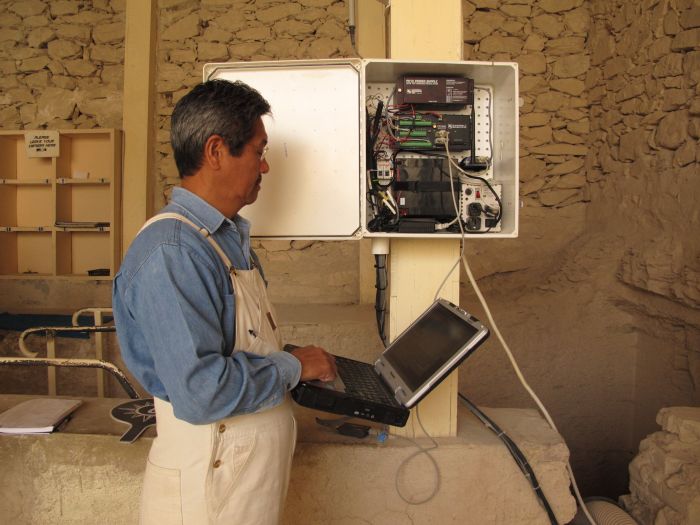






1922 年、エジプトの王家の谷でツタンカーメンの墓がそのままの状態で発見されたとき、墓には財宝、美術品、その他の遺物が満載でした。考古学者が発見した他の墓のほとんどでは、保存専門家が保護する前に、これらの品々は盗まれたり破壊されたりしていました。ツタンカーメンの墓のほとんどの内容物はカイロの博物館に移されましたが、ミイラ、珪岩の石棺とその花崗岩の蓋、壁画は訪問者が楽しめるように現地に残されています。現在、この墓は王家の谷で最も訪問者が多い場所の 1 つです。
墓の壁はツタンカーメンの死後の世界への旅を描いた貴重な壁画で覆われているが、時が経つにつれ、絵画は劣化し始めていいます。2009年、エジプトの最高考古評議会(現在はエジプト観光考古省)とゲッティ保存研究所は、訪問者が墓の状態に与える影響を評価し、管理するための多段階計画で協力しました。主な課題は、墓の状態、毎日の訪問による悪影響、壁画やその他の残存遺物に対する環境リスクを理解することでした。プロジェクトの計画は、墓内のセンサーと墓の外にある気象観測所からデータを収集し、分析することでした。
当初は、墓の入り口近くに電池式の自動気象観測所が設置され、気温、相対湿度、日射量、風速と風向、降雨量など、墓所の一般的な気候を監視していました。墓の内部には、内部の気温、相対湿度、露点温度、二酸化炭素濃度などの微気候条件を監視するセンサーが設置されていました。
頻繁なデータ分析を可能にするために、携帯電話モデムとデータロガーを使用して、プロジェクトの本部であるゲッティ保存研究所のロサンゼルス事務所にデータを送信しました。その後、データはプロジェクトの Web サイトに自動的に掲載されました。
データの分析により、墓への空気の流入と流出が不足していることが、相対湿度の上昇につながっていることが分かりました。墓への頻繁な訪問者も、二酸化炭素濃度が高く、内部の気温と相対湿度が急激に変動する不安定な微気候の一因となっていました。さらに、この人気の高い場所への頻繁な訪問 (歩行者) と風により、空中に浮遊する微粒子 (ほこり) が墓内に入り込みやすくなりました。これらの要因は、今度は壁画やその他の遺物の劣化につながりました。2013 年に、プロジェクトの初期データ収集フェーズが完了した後、元のシステムは解体されました。
プロジェクトの次の段階では、ゲッティ保存研究所とエジプト観光遺跡省のメンバーがデータを分析し、この史跡の保存における訪問者と環境への影響を管理する戦略を策定しました。墓の環境条件を安定させ、ほこりの量を減らすための取り組みには、フィルター付き空気供給および排気換気システムの導入、およびインフラストラクチャの改善が含まれていました。
2016 年、フィルター付き空気供給の換気システムが設置された後、絵画やその他の工芸品の保存状態と適用された保存対策の有効性を確認するために、第 2 段階のモニタリングが開始されました。キャンベル サイエンティフィックから選ばれたモニタリング機器は、ほこりっぽい環境でも問題なく機能する堅牢なものでなければなりませんでした。さらに、専門知識が最小限で済み、現地で簡単に入手できるツールや交換部品を使用するという点で、メンテナンスの手間がかからないものでなければなりませんでした。
新しい自動気象ステーションは、墓の入り口の外側の気象状況を監視します。墓内のセンサーは、微気候、特に気温と相対湿度を監視します。このデータは、空気換気システムを制御し、環境状況に基づいて関係者に電子メールアラームを生成するために使用されます。
フィルター付き給排気換気システムを導入し、環境データを綿密に監視することで、墓内の環境が改善されました。その結果、保存専門家は墓の絵画やその他の遺物を年間を通じて訪問者が楽しめるよう維持できるようになりました。
ゲッティ保存研究所とのプロジェクトは2019年に正式に終了しましたが、地元の保存スタッフは今でも季節ごとのデータ分析を実施し、訪問者管理戦略が墓の微気候や墓の遺物の全体的な状態に及ぼす効果を評価しています。この分析は、保存対策の持続可能性を確保し、ツタンカーメンの墓の遺産が将来の世代のために保護され、保存されることに役立ちます。
ケーススタディの概要
アプリケーション
史跡の環境条件の監視場所
エジプト、王家の谷使用製品
RAVENXTG TE525MM-L CS11-L PS150 HMP45C-L 05103-L LI200X-L SP10 CR1000寄稿者
Shin Maekawa and Vincent Beltran, Getty Conservation Institute参加団体
観光・遺跡省(エジプト)計測項目
気温、相対湿度、日射量、風速と風向、降雨量、二酸化炭素、露点温度関連ウェブサイト
Conservation and Management of the Tomb of Tutankhamen (2009–2019)参加コンサルタント/インテグレーター
Helio ScientificPDFで見る